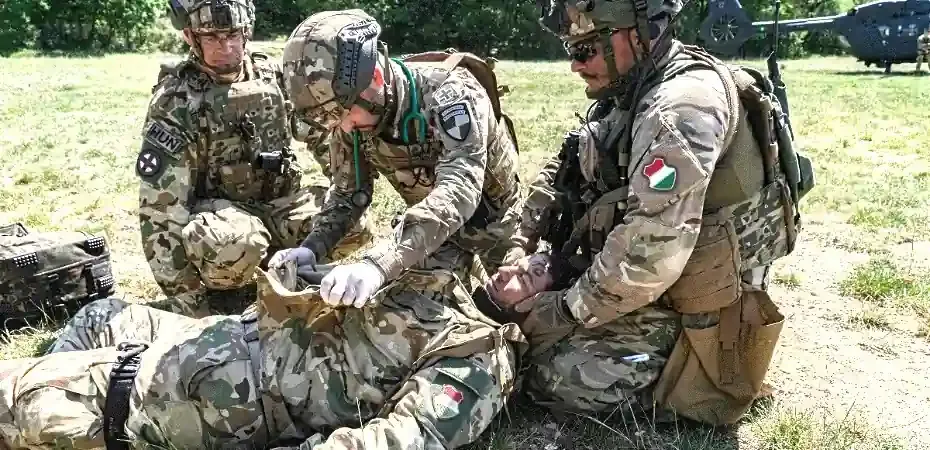
Tactical Combat Casualty Care
Overview
The Tactical Combat Casualty Care (TCCC) course is designed to provide participants with advanced medical skills and techniques required to treat casualties in combat or high-risk environments. This course focuses on the unique challenges of providing medical care under fire and in austere, tactical settings, preparing students to effectively respond to life-threatening injuries while maintaining operational security.
Developed to align with the guidelines of the Committee on Tactical Combat Casualty Care (CoTCCC), the course covers the three phases of tactical care: Care Under Fire, Tactical Field Care, and Tactical Evacuation Care.
Duration
10 Days
Training Cost
€ 2500

Objectives
- Understand the principles of Tactical Combat Casualty Care and its three phases: Care Under Fire, Tactical Field Care, and Tactical Evacuation Care.
- Learn and apply techniques for hemorrhage control, including the use of tourniquets, hemostatic agents, and pressure bandages.
- Master airway management in combat settings, including techniques for maintaining a patent airway and performing cricothyrotomy or needle decompression.
- Recognize and treat tension pneumothorax, open chest wounds, and other thoracic injuries.
- Understand shock management, fluid resuscitation, and other critical care interventions in the field.
- Safely move and evacuate casualties from hostile environments while maintaining situational awareness and operational security.
- Practice triage, patient assessment, and injury management under simulated combat conditions.
- Develop communication and coordination skills to work effectively with other team members and emergency responders during medical evacuations.
Topics
Module 1: Introduction to Tactical Combat Casualty Care (TCCC)
- Overview of TCCC principles and objectives
- History and development of TCCC guidelines (CoTCCC)
- The importance of lifesaving interventions in combat zones
- Phases of Tactical Care:
- Care Under Fire (CUF)
- Tactical Field Care (TFC)
- Tactical Evacuation Care (TACEVAC)
Module 2: Care Under Fire (CUF)
- Threat assessment and maintaining situational awareness
- Tactical considerations for medical intervention during combat
- Movement techniques under fire (carrying or dragging casualties)
- Hemorrhage control techniques:
- Tourniquet application (self-aid and buddy-aid)
- Direct pressure and wound packing in high-stress scenarios
- Understanding ballistic injuries and their implications on care
Module 3: Tactical Field Care (TFC)
- Conducting a primary survey in tactical environments
- Airway management:
- Jaw thrust and head-tilt maneuvers
- Nasopharyngeal airway insertion
- Cricothyrotomy
- Breathing and chest injuries:
- Recognizing tension pneumothorax
- Needle decompression techniques
- Treating open chest wounds with chest seals
- Circulatory assessment and control:
- Wound packing and use of hemostatic agents
- Managing shock and initiating IV/IO access
- Hypothermia prevention in trauma patients
Module 4: Tactical Evacuation Care (TACEVAC)
- Evacuation priorities and methods (ground vs. air evacuation)
- Triage principles in combat scenarios
- Loading and moving casualties while maintaining security
- Pain management and administering medications (analgesics and antibiotics) in the field
- Communication with medevac units and documentation of casualty care (MIST Report: Mechanism, Injuries, Symptoms, Treatment)
Module 5: Trauma Management in Combat
- Managing common battlefield injuries:
- Blast injuries and burns
- Fractures and dislocations (splinting techniques)
- Abdominal wounds and evisceration care
- Head injuries and traumatic brain injury (TBI) assessment
- Tourniquet conversion or reassessment after prolonged care
- Fluid resuscitation for hemorrhagic shock
Module 5: Trauma Management in Combat
- Managing common battlefield injuries:
- Blast injuries and burns
- Fractures and dislocations (splinting techniques)
- Abdominal wounds and evisceration care
- Head injuries and traumatic brain injury (TBI) assessment
- Tourniquet conversion or reassessment after prolonged care
- Fluid resuscitation for hemorrhagic shock
Course Conclusion and Testing
- Written Examination: Assessing knowledge of TCCC protocols and guidelines
- Practical Assessment: Evaluating the application of TCCC skills in simulated combat scenarios
- Certification: Successful completion of both written and practical assessments leads to certification in Tactical Combat Casualty Care (TCCC)
Weapons & Ammo
- Glock 17/19
- AK/M4
- 9 mm: 250 Rds
- 7.62 mm : 250 Rds
Inclusions
- Training
- Certification
- Weapons
- Ammo
- Tactical Gear
- Food & Accommodation
- T-Shirt
- Patch
- Pick & Drop: Airport to Hotel/Hotel to Training Area
- Visa Assistance
Experience
Basic Combat Medicine / First Aid Course Recommended
Things to Carry
- Tactical Pants
- Tactical Shoes/Boots
- Tactical Eye Protection Glasses
- Tactical Belt
- Tactical Gloves
- Tactical Elbow & Knee Pads
- Clothing Appropriate For Climate And Conditions
Documents to Carry
- Passport
- National ID
